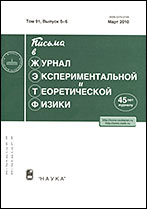|
|
Pis'ma v Zhurnal Èksperimental'noi i Teoreticheskoi Fiziki, 2006, Volume 84, Issue 6, Pages 397–402
(Mi jetpl1145)
|
 |
|
 |
This article is cited in 12 scientific papers (total in 12 papers)
CONDENSED MATTER
Band structure and optical transitions in semiconducting double-wall carbon nanotubes
D. V. Makaev, P. N. D'yachkov
Kurnakov Institute of General and Inorganic Chemistry, Russian Academy of Sciences
Abstract:
The electronic structure of semiconducting double-wall carbon nanotubes (CNTs) is calculated using the linearized augmented cylindrical wave method. The consideration is performed in the framework of the local density functional theory and the muffin-tin (MT) approximation for the one-electron Hamiltonian. The electronic spectrum of a double-wall CNT is determined by the free motion of electrons in the interatomic space of the two cylindrical layers, scattering by the MT spheres, and tunneling through the classically impenetrable region. Calculated results for double-wall CNTs of the (n, 0)@(n′, 0) zigzag type indicate that the shift of the band-gap width depends on whether n and n′ are divided by 3 with a remainder of 1 or 2. It is found that, regardless of the type of the inner tube, the energy gap E g of the outer tube decreases by 0.15–0.22 eV if the tube belongs to the sequence n = 2 (mod 3). For the outer tubes of the sequence n = 1 (mod 3), the shifts of the band gap ΔE g are always negative −0.15 ≤ ΔE g ≤ −0.05 eV. In both cases, the shifts ΔE g weakly oscillate rather than decrease in going to tubes of a larger diameter d. For the inner tubes, the changes in the band gap ΔE g are more sensitive to the diameter. At 10 ≤ n ≤ 16, the shifts ΔE g are positive and the maximum value of ΔE g equals 0.39 and 0.32 for the sequences n = 2 (mod 3) and n = 1 (mod 3), respectively. In going to the inner tubes of a larger diameter, ΔE g rapidly drops and then oscillates in the range from −0.05 to 0.06 eV. The calculated results indicate that the shifts of the optical band gaps in core and shell tubes upon the formation of double-wall CNTs are significant, which must hinder the identification of double-wall CNTs by optical methods. On the other hand, the obtained results open up possibilities for a more detailed classification of double-wall nanotubes.
Received: 10.08.2006
Citation:
D. V. Makaev, P. N. D'yachkov, “Band structure and optical transitions in semiconducting double-wall carbon nanotubes”, Pis'ma v Zh. Èksper. Teoret. Fiz., 84:6 (2006), 397–402; JETP Letters, 84:6 (2006), 335–339
Linking options:
https://www.mathnet.ru/eng/jetpl1145 https://www.mathnet.ru/eng/jetpl/v84/i6/p397
|


|





 Contact us:
Contact us: Terms of Use
Terms of Use
 Registration to the website
Registration to the website Logotypes
Logotypes









